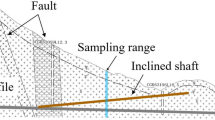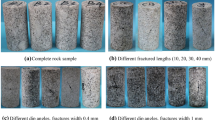Summary
Post-Failure Behavior of a Granite and Diabase
Compression experiments have been performed on Westerly granite and Frederick diabase at a mean strain rate of 0 (10−5) sec.−1. In such tests Westerly granite and Frederick diabase exhibit Class II failure behavior between zero and 22000 psi and between 500 psi and 2200 psi, confining pressure respectively. In order to control brittle failure in these rocks, therefore, energy must be extracted from the samples.
Complete stress-strain curves for Westerly granite can be divided into a number of characteristic regions. Each of these regions can be described in terms of distinct fracture patterns. In Westerly granite in uniaxial compression and at less than 2 900 psi confining pressure, the fracture patterns consist of local cracks predominantly parallel to the direction of greatest compression, slabs and narrow intensely crushed shear zones. At greater 2 900 psi confining pressure the fracture patterns consist of local cracks predominantly inclined to the direction of greatest compression and of macroscopic shear fractures. At high confining pressure, local cracks tend to propagate in their initial plane. The fracture patterns in Frederick diabase are sensibly the same as those in Westerly granite at 22000 psi confining pressure.
The ultimate strength of Westerly granite above 22000 psi confining pressure and in Frederick diabase is controlled by faulting. At lower confining pressure faulting in granite occurs only in the post-failure region beyond the peak of the stress-strain curves.
Preliminary experiments suggest that creep in Westerly granite under high and constant stress produces the same fracture patterns that occur in the post-failure region in continuous-deformation tests. In uniaxial compression creep terminates in macroscopic fracture near the intersection of the constant stress-strain path of a creep sample with the post-failure branch of the stress-strain curve of a quasi-statically loaded specimen.
A comparison of all fracture patterns suggests that the fracture mechanisms in rock depend upon confining pressure, mineral composition and grain size of the rocks tested. It is unlikely, therefore, that rock failure in compression can in general be described by a single failure criterion.
Zusammenfassung
Verhalten von Granit und Diabas nach dem Bruch
Druckversuche an Westerly-Granit und Frederick-Diabas bei einer mittleren Stauchungsgeschwindigkeit von 0 (10−5) sec−1 haben ergeben, daß Granit in den Grenzen von Null bis 22000 psi Manteldruck und Diabas zwischen 500 psi und 2200 psi Manteldruck ein Bruchverhalten der Klasse II aufweisen. Um den Bruchvorgang im “post-failure”-Bereich zu kontrollieren ist es daher notwendig, daß den Prüfkörpern Energie entzogen wird.
Vollständige Kennlinien von Granit und Diabas können in eine Reihe von charakteristischen Abschnitten unterteilt werden, die jeweils bestimmte und ihnen eigene Brucherscheinungen aufweisen. Bei einachsiger Belastung und im Triaxialversuch unterhalb 2900 psi Manteldruck bestehen die Brucherscheinungen in Westerly-Granit aus feinen, über den Probekörper verteilten Haarrissen, vornehmlich parallel zur Auflast, aus Schalen sowie aus dünnen, intensiv aufgemahlenen Scherzonen. Der Makroskopische Bruch erfolgt als Verschiebungsbruch. Oberhalb 2900 psi Manteldruck entstehen Haarrisse, die vornehmlich zur Auflast geneigt sind und die bei fortschreitender Verformung des Prüfkörpers in ihrer ursprünglichen Ebene weiter aufreißen. Der sichtbare Bruch erfolgt bei hohem Manteldruck als Gleitungsbruch. Die Brucherscheinungen in Frederick-Diabas sind denen in Westerly-Granit bei 22000 psi Manteldruck nahezu gleich.
Die Bruchfestigkeit von Westerly-Granit bei 22000 psi Manteldruck und in Frederick-Diabas ist von der Ausbildung von Gleitungsbrüchen bestimmt. Bei niedrigerem Manteldruck entstehen Gleitungs- oder Verschiebungsbrüche in Granit jedoch erst im “post-failure”-Bereich nach teils erheblicher Überschreitung der Bruchfestigkeit.
Vorläufige Ergebnisse deuten darauf hin, daß das Kriechen in Westerly-Granit unter hoher Spannung durch die gleichen Brucherscheinungen hervorgerufen oder von ihnen begleitet wird, die im “post-failure”-Bereich in quasi-statischen Versuchen beobachtet werden können. Im einachsigen Druckversuch führen Kriecherscheinungen ungefähr dann zum Bruch, wenn die Kennlinie einer Kriechprobe die Kennlinie eines ebenfalls einachsig aber quasistatisch belasteten Prüfkörpers im “post-failure”-Bereich schneidet.
Ein Vergleich der Brucherscheinungen in einigen Gesteinen läßt darauf schließen, daß sich die Bruchmechanismen in Gesteinen mit der Höhe des Manteldrucks und mit der Beschaffenheit des Gesteins ändern. Es ist daher unwahrscheinlich, daß der Bruch von Gesteinen mit Hilfe eines einzigen Bruchkriteriums hinreichend beschrieben werden kann.
Résumé
Comportement post-rupture d'un granite et d'une diabase
Au cours d'expériences en compression à vitesse de déformation constante (10−5 sec−1) le granite de Westerly et la diabase de Frederick ont un comportement à la rupture dit de “classe II” pour des contraintes latérales variant entre 0 et 1500 bars pour le granite, et entre 30 et 150 bars pour la diabase. Il faut donc extraire de l'énergie des éprouvettes pour en contrôler la cassure.
Les courbes complètes effort-déformation du granite de Westerly peuvent être divisées en un certain nombre de régions caractérisées chacune par un réseau de fracture particulier qui dépend d'ailleurs aussi de la contrainte latérale. Lorsque celle-ci est nulle, ou inférieure à 200 bars, le granite de Westerly développe un réseau de fracture consistant en plaques, en étroites zones de broyage intense et en fissures essentiellement parallèles à la direction de compression maximale. Lorsque la contrainte latérale est supérieure à 200 bars, le réseau de fractures consiste en fractures de cisaillement macroscopiques et en fissures locales faisant pour la plupart un angle avec la direction de compression maximale. Pour des contraintes latérales élevées, les fissures locales ont tendance à se propager dans leur plan initial. Le réseau de fractures développé dans la diabase de Frederick, quelle que soit la contrainte latérale, est à peu près identique à celui qui se développe dans le granite de Westerly pour une contrainte latérale de 1500 bars.
Au dessus de 1500 bars de contrainte latérale, la charge de rupture des deux roches est régie par la formation d'une faille, alors qu'en dessous de 1500 bars une faille ne se forme dans le granite que dans la région qui suit la rupture, au delà du maximum de la courbe effort-déformation.
Des expériences préliminaires suggèrent que le fluage du granite de Westerly soumis à des contraintes constantes élevées produit un réseau de fracture identique à celui obtenu dans la région qui suit la rupture dans des essais de déformation continue. En outre, en compression uniaxiale, le fluage se termine par une fracture macroscopique près de l'intersection de la courbe de déformation à charge constante avec la partie décroissante de la courbe complète effort-déformation d'une éprouvette chargée de façon quasi-statique.
Une comparaison de tous les réseaux de fracture obtenus suggère que les mécanismes de fracture dépendent de la contrainte latérale, de la composition minéralogique et de la taille des grains de la roche éprouvée. Il est donc peu probable que la rupture des roches en compression puisse être en général décrite par un seul critère.
Similar content being viewed by others
References
Barnard, P. R.: Researches into the Complete Stress-Strain Curve for Concrete. Mig. Concrete Research16 49, 1964.
Bieniawski, T. Z.: Mechanism of Brittle Fracture of Rock. International Journal of Rock Mechanics Mining Science4 4, 1967.
Birch, F.: The Velocity of Compressional Waves in Rocks to Ten Kilobars, Part II. Journal of Geophysical Research66, 1961.
Brace, W. F.: Brittle Fracture of Rocks. State of Stress in the Earth's Crust. W. R. Judd, ed. American Elsevier Publishing Company, 1964.
Brace, W. F., and E. G. Bombolakis: Note on Brittle Crack Growth in Compression. Journal of Geophysical Research68 2, 1963.
Brace, W. F., B. W. Paulding, and C. H. Scholz: Dilatancy in the Fracture of Crystalline Rocks, J. Geophys. Res.71 16, 1966.
Brown, J. W., and M. M. Singh: An Investigation of Microseismic Activity in Rock under Tension. Transactions of the Society of Mining Engineering233 255–265, 1966.
Cook, N. G. W.: The Failure of Rock. International of Rock Mechanics and Mining Science2 4, 1965.
Handin, J.: Strength and Ductility. Handbook of Physical Constants, S. P. Clark, J., ed., 65A Nom.97, 1966.
Fairhurst, C., and N. G. W. Cook : The Phenomenon of Rock Splitting Parallel to the Direction of Maximum Compression in the Neighborhood of a Surface. Proceedings of the First Congress of the International Society of Rock Mechanics, Lisbon, Portugal, 1966.
Hoek, E.: Rock Fracture under Static Stress Conditions. CSIR Report MEG 383, Pretoria, South Africa, 1965.
Jaeger, J. C., and N. G. W. Cook: Fundamentals of Rock Mechanics. Methuen, 1969.
Mogi, K.: Study of Elastic Shocks Caused by the Fracture of Heterogeneous Materials and its Relation to the Earthquake Phenomena. Bulletin. Earthquake Res. Inst., Tokyo Univ.,40 pp. 125–144, 1962.
Scholz, C. H.: Experimental Study of the Fracturing Process in Brittle Rock. Journal of Geophysical Research73 4, 1968.
Simmons, G., and W. F. Brace: Comparison of Static and Dynamic Compressibility of Rocks. J. Geophys. Res.70 22, 1965.
Wawersik, W. R.: Detailed Analysis of Rock Failure in Laboratory Compression Tests. Ph. D. Thesis, University of Minnesota, 1968.
Wawersik, W. R., and C. Fairhurst: A Study of Brittle Rock Fracture in Laboratory Compression Experiments. International Journal of Rock Mechanics and Mining Science (in press).
Author information
Authors and Affiliations
Additional information
With 12 Figures and 5 Plates
Rights and permissions
About this article
Cite this article
Wawersik, W.R., Brace, W.F. Post-failure behavior of a granite and diabase. Rock Mechanics 3, 61–85 (1971). https://doi.org/10.1007/BF01239627
Received:
Issue Date:
DOI: https://doi.org/10.1007/BF01239627




